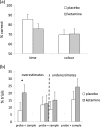Ketamine perturbs perception of the flow of time in healthy volunteers
- PMID: 21603893
- PMCID: PMC3210361
- DOI: 10.1007/s00213-011-2346-9
Ketamine perturbs perception of the flow of time in healthy volunteers
Abstract
Rationale: Disturbances in the subjective experience of time have been observed both in schizophrenia and following acute administration of ketamine. However, effects of ketamine on more objective timing tasks have not yet been measured in humans, nor has it been established that timing effects are not merely secondary to a more general dysfunction in working memory (WM).
Objective and methods: In a double-blind placebo-controlled crossover study, we characterised the effects of ketamine (100 ng/ml blood plasma level) on performance of perceptual timing and colour discrimination tasks, which were matched for WM and attentional demands. To test the ubiquity of ketamine's effects on timing, we also examined two distinct measures of temporal predictability.
Results: Ketamine significantly distorted the subjective experience of time as measured by the Clinician-Administered Dissociative States Scales. Critically, ketamine also impaired accuracy on the perceptual timing task while having no effect on performance of the colour perception task. Although ketamine did not impair the ability to use prelearned temporal (or spatial) cues to predict target onset (or location), it did slow reaction times at long delays following non-informative neutral cues, suggesting an impaired ability to use the unidirectional flow of time itself to make temporal predictions.
Conclusions: Ketamine induced selective impairments in timing, which could not be explained by more fundamental effects on the ability to hold information in WM. Rather our collected findings suggest that ketamine may disturb timing by selectively impairing the way in which information is temporally manipulated within WM.
Figures




References
-
- Bowers MB, Jr, Morton JB. Regional brain catecholamines and metabolites following THC, PCP and MK-801. Prog Neuropsychopharmacol Biol Psychiatry. 1994;18:961–964. - PubMed
-
- Bremner JD, Krystal JH, Putnam FW, Southwick SM, Marmar C, Charney DS, Mazure CM. Measurement of dissociative states with the Clinician-Administered Dissociative States Scale (CADSS) J Trauma Stress. 1998;11:125–136. - PubMed
Publication types
MeSH terms
Substances
Grants and funding
LinkOut - more resources
Full Text Sources

